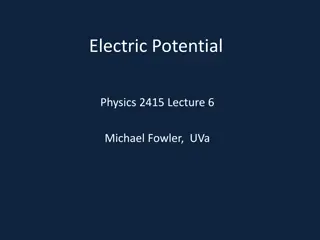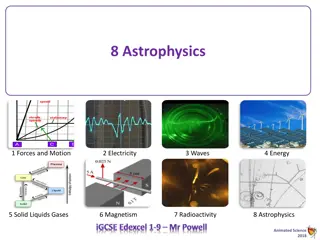Exploring Gravitational Energy and Its Limitations
Delve into the concept of gravitational energy, its practical applications, and limitations. Understand the relationship between gravity, work, and energy in a gravitational field, while also exploring topics such as escape energy, escape speed, binding energy, and the preservation of mechanical energy.
Download Presentation

Please find below an Image/Link to download the presentation.
The content on the website is provided AS IS for your information and personal use only. It may not be sold, licensed, or shared on other websites without obtaining consent from the author. Download presentation by click this link. If you encounter any issues during the download, it is possible that the publisher has removed the file from their server.
E N D
Presentation Transcript
GRAVITATIONAL ENERGY Let s Remove Some Limitations
EG= MGH What are the limits of this equation? Height we need a reference point that can t vary g Must be constant so it only works for a few hundred km
IN A GRAVITATIONAL FIELD Work needs to be done to raise an object in a gravitational field This work is equivalent to the amount of gravitational energy gained Remember: Work against gravity required a force equivalent to the force of gravity to be applied W=Fg d = mg y
DERIVE ??? - ??? ??= ?2 ?1
GEOMETRIC AVERAGES We are going to use a geometric average as opposed to a regular average to achieve a more accurate average value for our inverse parabola Let s take a look at what these values looks like
WHAT HAPPENS WHEN R INCREASES? ??= ??? ?2
GRAVITY WELLS AND WARPING OF SPACE TIME https://www.youtube.com/watch?v=MTY1Kje0yLg
ESCAPE ENERGY Minimum kinetic energy required to project mass (m) from surface of mass (M) to just escape gravitational force of M ??= ??
ESCAPE SPEED Minimum speed required to project mass (m) from surface of mass (M) to just escape gravitational force of M
BINDING ENERGY - Additional kinetic energy required by mass (m) to escape gravitational attraction of mass (M) - If you have binding energy, there is no escape from the gravity well
MECHANICAL ENERGY STILL HOLDS EM= Eg+ Ek
EXAMPLE A) How much energy do you need to escape Earth s gravitational field? B) How about to just a distance 4reaway? C) If an object was orbiting 4reaway from the Earth, what additional energy would it need to escape?
WHAT ABOUT AN OBJECT IN ORBIT? What do we know about an object in orbit?
WARPING OF SPACE TIME https://www.youtube.com/watch?v=jlTVIMOix3I
WHAT IS A BLACK HOLE? We call it a singularity, an extremely dense, extremely heavy, extremely small bit of mass Since it is so heavy, the force of gravity is MASSIVE
COMMON BLACK HOLES Primordial Black Hole - Size of an atom, mass of a mountain - Formed in the early universe
COMMON BLACK HOLES Stellar Black Hole - 20 times the mass of the sun, diameter of 10 miles - May be dozens of these black holes in the milky way - Formed during a super nova
COMMON BLACK HOLES Super Massive Black Holes Typically, a million times the mass of the sun, radius about the size of the solar system
SUPER MASSIVE BLACK HOLE In the Milky Way, - Called Sagittarius A - Mass equal to 4.3 million suns and would fit inside a ball the size of the sun
Class Mass Size ~105 1010MSun Supermassive black hole ~0.001 400 AU ~103MSun ~103km REarth Intermediate-mass black hole Stellar black hole ~10 MSun ~30 km Micro black hole up to ~MMoon up to ~0.1 mm
WHAT WOULD HAPPEN IF YOU WERE ON THE SURFACE OF THE SINGULARITY AND YOU TURNED ON A LIGHT?
THE GRAVITY WOULD BE SO STRONG, IT WOULD PULL LIGHT BACK IN!
THE EVENT HORIZON The line at which no light can escape from a black hole No event can be seen within because no light escapes! Since no light escapes, everything inside looks black (no light), therefore, a black hole
WHEN YOU FALL INTO THE BLACK HOLE Due to a difference in gravity between your head and feet, your feet fall faster than your head This is true on Earth but the force doesn t differ much At a point, you ll snap into two pieces as you fall
YOU WILL SURVIVE THE SNAP! (Until you bleed to death) The remaining halves with continue to snap in half This will continue until you are a stream of atoms that is travelling downwards
NOT THE WORST! As you stretch, you will also be squeezed (consider it spaghettification)
As space clouds (dust and gas) move towards the centre of the black hole, they tend to spiral inwards (like a toilet) As they do, the parts closer to the BH, spiral quicker than the parts furthur away This creates friction and heats the clouds to millions of degrees and they become a source for x-rays and ultraviolet
BLACK HOLES AND ESCAPE SPEED - A black hole is black because light cannot escape it s gravitational pull - It s very small and very dense with an immense gravitational field - Since light cannot escape, the speed of light is less than the escape speed
EVENT HORIZON The radius of black hole from which no event can be seen inside due to light s inability to escape the gravitational field of the singularity The Schwartzchild radius is the radius of the event horizon Let s calculate the Schwartzchild radius!!!!
EXAMPLE Let s say a star 100 x the mass of the Sun dies and forms a black hole. What would the Schwartzchild radius be?
6.3 Pg 293 Q7-11 Pg 294 Q1-9 Review Pg 298 Q1-3, 6-10, 20-26 Pg 300 Q3, 6, 7, 11-14, 16, 19























